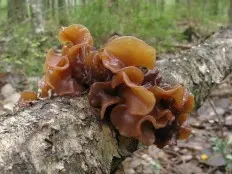Exidia sugar (Exidia saccharina)
- Division: Basidiomycota (Basidiomycetes)
- Subdivision: Agaricomycotina (Agaricomycetes)
- Class: Agaricomycetes (Agaricomycetes)
- Subclass: Auriculariomycetidae
- Order: Auriculariales (Auriculariales)
- Family: Exidiaceae (Exidiaceae)
- Genus: Exidia (Exidia)
- Type: Exidia saccharina (Exidia sugar)
:
- Tremella spiculosa var. saccharina
- Tremella saccharina
- Ulocolla saccharina
- Dacrymyces saccharinus

The fruit body in youth resembles a dense oily drop, then grows into an irregularly shaped angular-folded, sinuous formation 1-3 centimeters in diameter, adherent to the wood with a narrow side. Fruiting bodies located nearby can merge into large groups up to 20 cm, the height of such aggregates is about 2,5-3, possibly up to 5 centimeters.
The surface is smooth, glossy, shiny. In the convolutions and folds on the surface of young fruiting bodies there are scattered, rare “warts” that disappear with age. The spore-bearing layer (hymenum) is located on the entire surface, therefore, when the spores ripen, it becomes dull, as if “dusty”.
The color is amber, honey, yellowish-brown, orange-brown, reminiscent of the color of caramel or burnt sugar. With aging or drying, the fruiting body darkens, acquiring chestnut, dark brown shades, up to black.
The texture of the pulp is rather dense, gelatinous, gelatinous, flexible, elastic, translucent to the light. When dried, it hardens and turns black, retaining the ability to recover, and after rains it can develop again.

Smell and taste: not expressed.
spore powder: white.
Споры: cylindrical, smooth, hyaline, non-amyloid, 9,5-15 x 3,5-5 microns.
Distributed in the temperate zone of the northern hemisphere. It grows from early spring to late autumn, with short-term frosts it retains the ability to recover, withstands temperatures as low as -5 ° C.
On fallen trunks, fallen branches and deadwood of conifers, it prefers pine and spruce.
Sugar exsidia is considered inedible.

Leafy trembling (Phaeotremella foliacea)
It also grows mainly on coniferous wood, but not on the wood itself, but parasitizes on fungi of the Stereum species. Its fruiting bodies form more pronounced and narrow “lobules”.
Photo: Alexander, Andrey, Maria.









